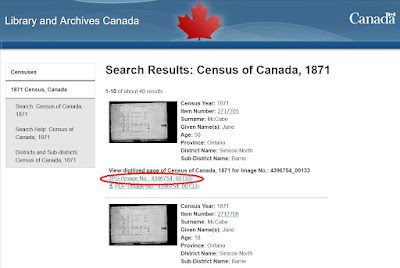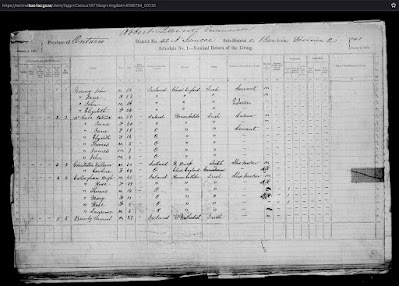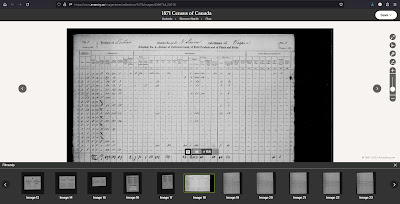Along with people asking about finding Ontario birth certificates, which I discuss in my post "Beginner's Guide: Finding Ontario Civil Birth Registration", folks want to locate the death certificates for their long departed kin.
Before I begin this guide, I would recommend people read the "Death Registrations" page from the Archives of Ontario along with their "Research Guide 202 - Vital Statistics Records" to gain a basic understanding of what is available and why.
Registration or Certificate?
Keep in mind that usually folks aren't actually looking for the death certificate but a copy of the completed death registration. When my father passed away a few years ago the paperwork that was filled in was titled "Statement of death - Form 15" and also included "Medical Certificate of Death - Form 16" completed my the physician. The "Statement of death" has all the details about someone's death such as when and the place where they died, where they resided, the names of their parents, and the name and address of the informant. The "Medical Certificate of Death" includes all the information about their cause of death. There is also the Ontario Death Certificate but that document usually only has a name, the sex, marital status, date and place of death, age, date of registration, and the registration number.
As genealogy and family history researchers we generally want the document with as much information as possible. So if requesting a document concerning the death of someone and the records are only available through ServiceOntario via their "How to get a copy of an Ontario death certificate online" page you will want to try to get the "Certified copy of death registration" or even the "Certified copy of death registration with cause of death information". Of course, due to privacy reasons, not everyone can request a certified copy so you may need to have a relative make the application on your behalf.
Years Covered
Death registrations are only publicly available from 1869 to 1951 from the Archives of Ontario. For death registrations registered after 1951, those are still currently held by the Office of the Registrar General of Ontario and can only be requested via Service Ontario. The registrations that are no longer protected by the veil of privacy are transferred from the Office of the Registrar General to the Archives of Ontario on a yearly basis for safekeeping and public access.
Why 1869 and not 1867 when Ontario became a province of the Dominion of Canada? It wasn't until January 23, 1869 when "An Act to provide for the Registration of Births, Marriages and Deaths" was assented to by the Crown. In that act it states that "This Act shall come into force on the first day of July, one thousand eight hundred and sixty-nine..." That is why you generally may not find any early deaths recorded in the civil death registrations. Although there are a few from before the July 1, 1869 date found in the records they were registered several years later after the death. But those very few entries are the exception.
Where are the Records?
Before diving into where the registrations may be found, it is worth noting that the format of the registration forms changed over the years. One may come across the form with six boxes per page, or with spots for only three registrations in a column format. The more recent registration forms only have a single registration of death on the page.
However, there was also a registration form that is laid out horizontally. Both FamilySearch and Ancestry will generally only show you the left side of this two page register. So make sure you also get the second part of that register page!
Archives of Ontario
The Archives of Ontario is the repository for those registrations transferred from the Office of the Registrar General. If you are living in or visiting Toronto, Ontario then you can drop by the Archives of Ontario and look at the various microfilms in person. This includes the years 1948 to 1951 since they aren't available online yet. However, according to the Archives of Ontario site, the microfilms holding the 1949-1951 registrations aren't available since they are in the process of being digitized. So always check the Death Registrations page from the Archives of Ontario or email them for up to date information before visiting in person.
It is important to note that the Archives of Ontario does not have the death registrations available on their web site.
FamilySearch
FamilySearch has the digitized microfilms of the Ontario death registrations and indexes from 1869 to 1937 in their "Deaths - registration, 1869-1937 and index, 1869-1937" collection. This collection is freely available for use from the comfort of one's abode. FamilySearch also has their dedicated search page "Canada, Ontario Deaths, 1869-1937 and Overseas Deaths, 1939-1947" to aid you in your efforts to find a death registration so that you don't have to manually go through the digitized indexes and registrations.
You might notice that FamilySearch has "Overseas Deaths, 1939-1947" included in that search page. Those are the deaths of Ontarians who died overseas due to the Second World War. The images for those registration are found on FamilySearch in their "Ontario statistics overseas--deaths, 1939-1947" collection. Quite often the completed civil death registration is a bit sparse on the details but it is a great clue that you should probably look up that person's Second World War service file in the Library and Archives Canada "Second World War Service Files – War Dead, 1939 to 1947" database.
FamilySearch, in addition to their indexes created by way of their transcriptions of the registrations, also has the images of the government created Vital Statistics Index (VSI) for deaths on their site. In the days before the Internet and the mass indexing projects, the VSI is what folks would consult first on microfilm before looking on the applicable microfilm that held the registration of death form for the person they were seeking.
 |
| Ontario Registrar General, Deaths - registration, 1869-1937 and index, 1869-1937, (Archives of Ontario, Toronto), 1913: extract from page for Carrick, Michael to Carscallen, Oswald Gurney; FamilySearch (www.familysearch.org: 27 Feb 2023), DGS 8105303, image 16. |
Yet even now these Vital Statistics Indexes are still useful to us. One reason is that the indexes are alphabetical by surname. One can, with practice, quickly glance through the years for possible names that have been "interestingly" read and transcribed from the original documents.
You might notice that in the "CONT." column in the example above for the VSI there are two codes: 91 and 21. The 91 indicates that it is a death (9) and is the original entry (1) where as the 21 indicates that it is a stillbirth (2) original entry (1).
What about finding online those deaths after 1937? For those we need to turn to Ancestry.
Ancestry
On Ancestry we have their "Ontario, Canada, Deaths and Deaths Overseas, 1869-1948" collection which has the death registrations from 1869 up to 1948. That collection includes the deaths related to those Ontarians who died overseas due to the Second World War.
Other sites
Some might wonder where is Findmypast or MyHeritage in the list of genealogy sites to use to find Ontario civil death registrations? I wondered the same as I was writing this post. It seems that both Findmypast and MyHeritage don't have the registrations for Ontario. Findmypast has indexes for British Columbia, Manitoba, and Saskatchewan though.
One of the other sites I will sometimes use is The Ontario Vital Statistics Project. I like this site for a few reasons. The first is that the records are transcribed by folks not associated with FamilySearch or Ancestry. So they might see the written words differently. Also, the transcriptions are alphabetical in columns and I can quickly glance through a page.
 |
| Partial screen capture from The Ontario Vital Statistics Project for Ontario Death Registrations "McL-McY" Surnames page. |
Still Can't Find it!
It could be as simple as the death may not have been registered with the civil authorities. For a number of years, even decades, the civil registrations of births, marriage, and deaths in the Province of Ontario fell far short of 100% coverage. In one case I was looking at the mother's death wasn't registered but her young son's death the following year was. According to the law no one should have been buried without a death registration filed but often it slipped through the cracks.
So where else can one look for clues concerning a death if it can't be found in the civil registrations? Some possible sources include:
- Newspapers: I couldn't find a civil death registration for William Henry Chipman who died in Ottawa, Ontario on 10 Apr 1870. However, I did find his death in various newspapers since he was a member of the first parliament of Canada.
- Parish registers: It is important to remember that parish registers generally only record the burial of someone. If we are fortunate we will find that the parish priest or clerk will have also recorded the date of death in the register.
- Cemetery registers: Much like parish registers, cemetery registers are there to record the date of the burial. But since a person is not supposed to be buried before they are dead it can set an upper limit for the date when a person passed away.
- Monumental inscriptions on marker and memorial stones: However, don't necessarily trust the year or exact date found on a marker or memorial stone in a cemetery or graveyard. Sometimes the stone is a replacement and the date may be based on the memory of whomever is paying for the new marker. See my post from 2013 "Zombie in the census?" for an example of this issue. Also, just because a person has a marker in one place doesn't mean that they died in that community or are even buried in that cemetery.
- Schedule 2, "Nominal return of the deaths", from the 1871 Census of Canada: This schedule was supposed to record all deaths that took place in the year prior to the start of the 1871 Census of Canada which was 2 Apr 1871. Just like any other record made weeks or months after the event, the date in this schedule may be based on someone's faulty memory.
- City Directories: Sometime a clue can be found for the death of the male head of household. The directory entry may switch from his name to that of his wife and she will have "widow of..." after her name.
Even if the death has been registered and one has a copy of the registration, see if you can find other records about the death. I have run into a case where the civil registration of death has the wrong date recorded. Both the grave marker and the newspaper have a date several weeks before the "official" date in the civil registration. Since a newspaper doesn't often report on a death before it has occurred, in this case I actually trust the newspaper more than the government record.
Hopefully some of the guidance in this post will help you find those sometimes elusive civil death registrations in Ontario.

 Recently in a Facebook group the following question was posted:
Recently in a Facebook group the following question was posted:
%20sub-district%20list.jpg)





